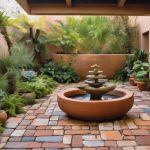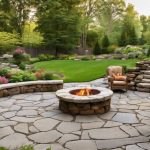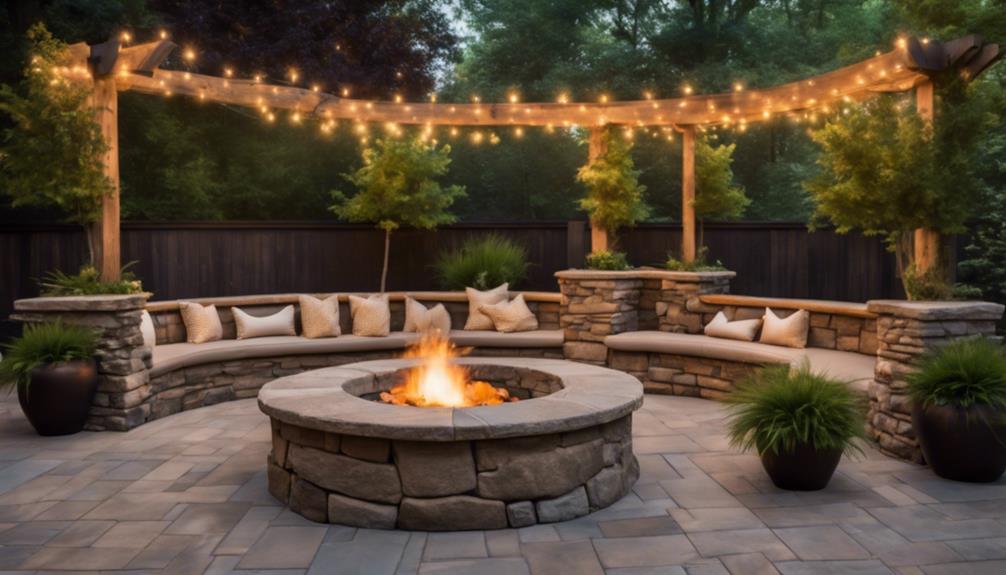
Top Plants to Enhance Your Hardscaping Design
24 October 2024
10 Tips for Outdoor Entertainment Hardscaping
24 October 2024Hardscaping involves the strategic use of durable materials to create inviting outdoor entertainment spaces. These spaces enhance aesthetic appeal while ensuring functionality and usability.
Key elements include patios, pathways, retaining walls, and outdoor fireplaces that promote seamless interaction within the landscape. Thoughtful design takes into account layout, lighting, and material selection to create harmonious environments.
Furthermore, hardscaping can significantly increase property value and provide low-maintenance solutions. By understanding proper drainage and sustainable practices, homeowners can ensure longevity and resilience.
There is much more to explore regarding the benefits and intricacies of hardscaping for outdoor gathering environments.
Hardscaping's Role in Entertainment
Hardscaping plays an essential role in enhancing outdoor entertainment areas through thoughtful design and layout considerations.
Selecting appropriate materials not only influences the aesthetic appeal but also ensures durability and longevity for these spaces.
Design and Layout Considerations
Creating an inviting outdoor entertainment space requires thoughtful design and layout considerations that seamlessly integrate hardscaping elements with the natural landscape.
Effective spatial planning is essential; delineating areas for dining, lounging, and recreational activities fosters a harmonious flow. Considerations such as sight lines, accessibility, and the relationship between built features and surrounding greenery improve usability.
Moreover, the arrangement of hardscaping materials—like patios, pathways, and retaining walls—should complement the architecture of the home while providing functional surfaces.
Lighting plays a pivotal role, accentuating pathways and gathering zones, while also contributing to safety.
Ultimately, a well-conceived design not only enhances aesthetic appeal but also cultivates a sense of connection to the environment, enriching the overall outdoor experience.
Material Selection and Durability
When selecting materials for outdoor entertainment spaces, durability and aesthetic appeal must go hand in hand to guarantee a lasting and functional environment.
High-quality materials such as natural stone, concrete pavers, and treated timber are crucial for enduring the elements while providing visual interest.
Stone offers unparalleled durability and a timeless look, while concrete pavers provide versatility in design.
Treated timber, though requiring maintenance, adds warmth and charm to outdoor settings.
Moreover, incorporating permeable materials can improve drainage and reduce erosion.
A thorough understanding of the materials' properties, including resistance to weathering, fading, and wear, ensures that your entertainment space remains inviting and functional for years to come.
Thoughtful selection fosters an enduring space for gatherings and leisure.
Design and Layout Considerations
When designing outdoor entertainment spaces, careful consideration of material durability and aesthetics is crucial to ensure longevity and visual appeal.
Furthermore, effective drainage and water management strategies must be integrated to prevent potential issues from rainfall or irrigation.
Material Durability and Aesthetics
Considering the dual demands of durability and visual appeal, selecting the right materials for hardscaping is crucial when designing outdoor entertainment spaces.
The integration of robust materials not only withstands the elements but also enhances the overall aesthetics of the area.
Key considerations include:
- Natural Stone: Offers timeless beauty and exceptional strength.
- Pavers: Adaptable and available in a range of designs, suitable for high traffic areas.
- Concrete: Durable and cost-effective, easily customisable with stains and textures.
- Brick: Classic appeal with excellent longevity and resistance to wear.
- Composite Decking: Combines durability with low maintenance, ideal for modern designs.
Drainage and Water Management
Effective drainage and water management are integral components of successful hardscape design in outdoor entertainment spaces. Proper planning ensures that water is efficiently directed away from structures and high-traffic areas, preventing erosion and damage.
Key design considerations include:
- Slope and Grading: Utilise a slight slope to facilitate natural water runoff.
- Drainage Solutions: Incorporate French drains or swales to manage excess water.
- Permeable Materials: Select permeable pavers to allow for groundwater infiltration.
- Rain Gardens: Include landscaped areas designed to absorb rainwater and filter pollutants.
- Regular Maintenance: Establish a routine to clear debris from drainage systems and ensure peak performance.
Lighting for Ambiance and Safety
Creating a well-thought-out lighting plan enhances both the ambience and safety of outdoor entertainment spaces. Effective lighting not only improves the aesthetic appeal but also ensures that areas are well-lit for gatherings during twilight hours.
Consider the following design and layout elements:
- Layered Lighting: Combine ambient, task, and accent lighting for a balanced effect.
- Pathway Illumination: Use low-level lighting to guide guests safely along walkways.
- Focus on Focal Points: Highlight features such as fire pits or water features with spotlights.
- Dimmable Options: Install dimmers to adjust brightness according to the occasion.
- Energy Efficiency: Opt for LED fixtures to reduce energy consumption while providing ample illumination.
A strategic approach to lighting enhances both functionality and enjoyment in outdoor settings.
Selecting Suitable Materials
Selecting suitable materials for hardscaping requires a careful initial site assessment to understand the specific conditions and requirements of the space.
Incorporating permeable paving options can enhance drainage and reduce environmental impact, while vertical elements can add visual interest and functionality.
These considerations are crucial for creating a cohesive and sustainable outdoor entertainment area.
Initial Site Assessment
An accurate initial site assessment is crucial for determining the most suitable materials for hardscaping outdoor entertainment spaces. This assessment involves evaluating various factors that influence material selection, ensuring durability and aesthetic coherence with the surrounding environment.
Key considerations include:
- Soil Type: Understanding drainage and load-bearing capacity.
- Climate Conditions: Gauging temperature fluctuations and precipitation patterns.
- Sunlight Exposure: Evaluating areas with varying light conditions throughout the day.
- Traffic Patterns: Identifying high-traffic zones to choose resilient materials.
- Design Compatibility: Ensuring materials align with the overall design vision.
Use Permeable Paving Options
While traditional paving materials can lead to water runoff and erosion, permeable paving options provide an effective solution for managing stormwater and enhancing outdoor entertainment spaces.
These materials allow water to infiltrate, reducing flooding and promoting groundwater recharge.
When selecting suitable permeable paving options, consider the following:
- Permeable Pavers: Interlocking systems that create gaps for water absorption.
- Gravel: A versatile and cost-effective option with excellent drainage properties.
- Porous Concrete: Offers a solid surface while allowing water to pass through.
- Permeable Asphalt: Designed for heavy use, combining durability with permeability.
- Grass Pavers: Allow grass to grow through the paving, blending aesthetics with functionality.
Incorporating these materials fosters sustainable designs while enhancing the functionality of your outdoor space.
Incorporating Vertical Elements
Incorporating vertical elements into your outdoor entertainment space not only enhances visual interest but also optimises functionality.
Selecting suitable materials is essential for achieving a cohesive and durable design. Consider the following options to improve your space effectively:
- Wood: Provides warmth and a natural aesthetic; ideal for trellises and pergolas.
- Metal: Offers a modern appeal; perfect for railings, sculptures, or fencing.
- Stone: Delivers a timeless look; excellent for retaining walls or garden beds.
- Glass: Creates a contemporary feel; can be used for privacy screens or partitions.
- Plants: Adds life and colour; vertical gardens or climbing plants enhance greenery.
Increased Property Value
Hardscaping elements, such as patios, pathways, and retaining walls, can significantly enhance the aesthetic appeal and functionality of outdoor spaces. These improvements not only create inviting environments for entertaining but also considerably increase property value. A well-designed hardscape can attract potential buyers by showcasing a low-maintenance landscape and versatile outdoor living areas.
| Hardscaping Feature | Impact on Property Value |
|---|---|
| Patios | Expands usable living space |
| Pathways | Improves navigation and flow |
| Retaining Walls | Prevents erosion, adds structure |
| Outdoor Fireplaces | Creates focal points, increases appeal |
Investing in quality hardscaping can yield substantial returns, making it a strategic component in any property improvement plan.
Sustainable Plant Selection Techniques
Sustainable plant selection is crucial for creating environmentally responsible outdoor entertainment spaces.
Techniques such as integrating rainwater harvesting systems, implementing rain gardens for effective stormwater management, and optimising irrigation systems can enhance the sustainability of these landscapes.
Rainwater Harvesting Systems
Rainwater harvesting systems are increasingly recognised for their ability to enhance outdoor entertainment spaces while promoting environmental sustainability. By collecting and utilising rainwater, these systems can significantly reduce water consumption and bolster landscape resilience.
Implementing such systems requires strategic planning and maintenance but offers numerous benefits:
- Cost Efficiency: Reduces utility bills through water conservation.
- Resource Management: Provides a sustainable water source for irrigation.
- Enhanced Aesthetics: Supports vibrant plant life and lush landscapes.
- Flood Mitigation: Alleviates stormwater runoff and erosion issues.
- Biodiversity Support: Encourages the growth of native plants adapted to local conditions.
Integrating rainwater harvesting systems fosters a sustainable outdoor environment that complements hard landscaping initiatives effectively.
Rain Gardens for Stormwater Management
Typically regarded as an effective solution for managing stormwater, rain gardens serve both functional and aesthetic purposes in outdoor spaces.
These specialised landscapes are designed to capture and absorb runoff, thereby reducing the risk of flooding and erosion while improving biodiversity.
The selection of appropriate plants is essential for maximising the garden's effectiveness and sustainability.
- Drought-resilient native species: Minimise water usage and support local ecosystems.
- Pollinator-friendly options: Attract beneficial insects while providing food sources.
- Deep-rooted perennials: Improve soil structure and enhance water infiltration.
- Seasonal interest: Incorporate plants that offer visual appeal throughout the year.
- Adaptability: Choose species suited to diverse soil and moisture conditions.
Irrigation System Integration
Effective management of outdoor spaces requires not only the implementation of rain gardens but also the integration of efficient irrigation systems.
These systems are essential for maintaining sustainable plant health and optimising water use. A well-designed irrigation system complements hardscaping by providing targeted moisture to plant life, reducing water waste, and enhancing the overall aesthetics of the space.
Key considerations for irrigation system integration include:
- Soil Moisture Sensors: Automate watering based on soil needs.
- Drip Irrigation: Deliver water directly to plant roots, minimising evaporation.
- Rainwater Harvesting: Utilise collected rainwater for irrigation purposes.
- Native Plant Selection: Choose plants that thrive with minimal irrigation.
- Smart Irrigation Controllers: Adjust schedules based on weather forecasts.
Implementing these techniques fosters a sustainable outdoor environment.
Soil Erosion Management Strategies
Effective soil erosion management is crucial for maintaining the integrity of outdoor entertainment spaces.
Implementing soil stabilisation techniques, incorporating retaining walls, and utilising natural stone features are key strategies to prevent erosion and enhance landscape aesthetics.
Soil Stabilization Techniques Applied
Soil stability is crucial for the longevity and functionality of outdoor entertainment spaces, particularly in relation to managing erosion. Implementing effective soil stabilisation techniques can greatly improve the resilience of these areas against environmental challenges.
- Vegetative Cover: Establishing deep-rooted plants to anchor the soil.
- Geotextiles: Using permeable fabrics to prevent soil displacement.
- Mulching: Applying organic or inorganic materials to retain moisture and reduce runoff.
- Terracing: Creating stepped levels to slow water flow and decrease erosion.
- Soil Amendments: Incorporating organic matter to improve soil structure and enhance water retention.
These strategies not only mitigate soil erosion but also contribute to the aesthetic and functional integrity of outdoor entertainment spaces.
Incorporate Retaining Walls
Often overlooked in the design of outdoor entertainment spaces, incorporating retaining walls is a crucial strategy for managing soil erosion.
These structures not only provide aesthetic appeal but also serve functional purposes, ensuring the stability of sloped landscapes. Retaining walls create level areas, prevent soil displacement, and improve drainage, contributing to the longevity of your outdoor space.
- Erosion Control: Retaining walls effectively minimise soil loss during heavy rains.
- Level Surfaces: They create usable flat areas for seating and activities.
- Aesthetic Appeal: Diverse materials can be used to complement your design.
- Planting Opportunities: Vertical gardens can thrive on retaining walls.
- Increased Property Value: Properly designed walls enhance the overall landscape.
Investing in retaining walls is a pivotal move for sustainable outdoor entertainment areas.
Incorporate Natural Stone Features
Incorporating natural stone features into outdoor entertainment spaces not only enhances their visual appeal but also serves as an effective strategy for managing soil erosion.
Natural stones can stabilise soil, reduce runoff, and promote water absorption, ensuring a healthy landscape.
Consider the following elements when integrating stone features:
- Retaining walls: Create terraces that minimise slope erosion.
- Stone pathways: Direct foot traffic and prevent soil compaction.
- Rock gardens: Improve drainage while providing aesthetic interest.
- Boulder placements: Serve as natural barriers against erosion.
- Dry creek beds: Channel water flow and reduce surface runoff.
Why Choose TKL Birmingham Gardener
When selecting a professional gardener for your outdoor entertainment spaces, TKL Birmingham Gardener stands out for its commitment to excellence and personalised service.
Their expertise in hard landscaping guarantees that every project is tailored to meet individual aesthetic and functional desires, transforming outdoor areas into stunning, usable spaces.
TKL's team employs high-quality materials and cutting-edge design strategies, ensuring durability and visual appeal.
Their collaborative approach prioritises client input, providing bespoke solutions that reflect your unique vision.
Moreover, TKL Birmingham Gardener stays abreast of industry trends and sustainable practices, ensuring that your investment not only enhances your property but also contributes positively to the environment.
For those seeking mastery in outdoor design, TKL is the quintessential choice.
Common Hardscaping Questions Answered
Numerous homeowners have questions regarding hardscaping, particularly as they seek to enhance their outdoor entertainment spaces.
One common inquiry revolves around material selection; concrete, stone, and paving slabs each offer distinct aesthetic and functional benefits. Homeowners often ask about the durability and maintenance requirements of these materials, emphasising the importance of choosing options that can withstand weather elements while maintaining visual appeal.
Another frequent concern is drainage; proper planning is crucial to prevent water accumulation, which can compromise hardscaped areas.
Furthermore, the integration of hardscaping with existing landscaping raises questions about design harmony and functionality.
Future Project Planning Essentials
Effective future project planning is crucial for homeowners looking to create functional and aesthetically pleasing outdoor entertainment spaces.
A well-thought-out plan not only optimises space but also integrates hardscaping elements seamlessly with landscaping features. To guarantee successful execution, consider the following necessities:
- Define Your Goals: Identify the primary purpose of the space, whether for relaxation, dining, or entertaining.
- Budget Wisely: Allocate resources for materials, labour, and unforeseen expenses.
- Research Materials: Select durable, weather-resistant materials suited to your climate.
- Consult Professionals: Engage landscape architects or designers for expert insights.
- Plan for Maintenance: Anticipate upkeep requirements to preserve the space's beauty and functionality.



